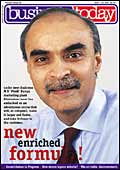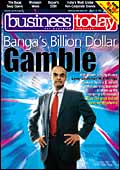 |
 |
 |
|
June 200
|
November 2001
|
August 2002
|
| Four to come:
For some time it looked like M.S. Banga's growth gambit
was working. Now, it emerges, the Chairman will have to try
harder |
It's
election day in Maharashtra. Streets and offices in Mumbai's financial
district are deserted as hundreds line up to exercise their franchise
or take that much-needed break at home. As anxious politicos go
into last minute huddles with key advisers, a group of middle-aged
men are in the midst of a brainstorming session that has nothing
to do with politics.
Deep inside Lever House-the Backbay Reclamation
headquarters of Hindustan Lever Limited (HLL), a stone's throw from
Mantralaya (state secretariat)-the management committee meeting
of the Home & Personal Care Division of the FMCG major is in
full swing. The agenda: How to revive the flagging fortunes of the
country's largest FMCG company.
|
RANK
5
|
RELIANCE
INDUSTRIES LIMITED
Impeccable pedigree and consistent
growth meant HLL shares were passed down in families for generations.
Then the rules of the Indian FMCG market changed |
Sure, the Indian subsidiary of the $47-billion
(Rs 2,16,200 crore) Anglo-Dutch conglomerate, Unilever, still figures
among the country's 10 largest corporations. But it's the only one
with the unenviable distinction of having seen its market capitalisation
plummet. It hit an all-time low following the declaration of this
year's Q2 (June) results (See What Ails Hindustan Lever). Despite
stagnating sales over the last two years, HLL had managed to cling
on to its profitability through some nifty cost cutting. But something
had to give. Its bottomline crumbled this June, plunging 43 per
cent to Rs 256 crore. The markets were swift and decisive in their
disapproval: HLL's share price hit a seven-year low of Rs 104 on
August 17, 2004.
|
KEY FINANCIALS
|
AVERAGE MARKET CAP FOR H1 2004-05
Rs 28,368.49 crore
TOTAL REVENUES IN 2003-04
Rs 10,598 crore
EPS IN 2003-04
Rs 6.71
PE RATIO AS ON SEPT. 30, 2004
18.69
ROCE 2003-04
23.34% |
Fifty-year-old Arun Adhikari, who is part of
HLL's apex five-member national management committee, gives an indication
of the prevailing mood inside Lever House. "We've recognised
the changed competitive environment and put in place steps that
will revitalise growth. There might be a sharp drop in profits,
but it's only temporary," he reassures. The soft-spoken Adhikari
is Managing Director of HLL's Household & Personal Care Division
and responsible for close to 70 per cent of the company's topline.
Talk alone may not convince investors. Once
one of Corporate India's crown jewels, the bluest-among-blue chips,
Hindustan Lever was an essential component of every savvy investor's
portfolio. Impeccable pedigree and consistent growth meant HLL shares
were passed down in families, often for generations. Then the rules
of the Rs 40,000-odd-crore Indian FMCG market changed.
 |
 |
| Turnaround men: Can S. Ravindranath
(L), MD, Food business and Arun Adhikari, MD, Household &
Personal Care Division revive HLL's flagging fortunes? |
David Versus Goliath
Aggressive regional brands like Cavincare,
Nirma and Ghari started eating into marketshares across key categories
like soaps, detergents, shampoos and toothpastes. Faster, nimbler
and more driven, they offered better value propositions and enticed
customers away despite having smaller marketing and promotion budgets.
At first the giant was dismissive, and by the time it woke up to
the threat, it was too late. Arch-rival Procter & Gamble's perfectly-timed
price cuts earlier this year dealt the final blow. HLL was under
pressure like never before in its 73-year history.
Industry watchers say it's sheer complacency
(arrogance would be too harsh a word) that's largely responsible
for HLL's current predicament. Used to growing at rates of 30 per
cent in the days when Keki Dadiseth was Chairman, managers thought
their days in the sun would never end. The warnings signs-and there
were plenty-were either not picked up or, worse, ignored. "Its
systems are very robust, but working in such a structured environment
can blunt the instincts and reaction times of managers," feels
the marketing head of a Mumbai-based FMCG company.
| Earlier this year,
HLL carried out a complete overhaul. Key management positions
were rejigged and five business units were compressed into two |
Given their penchant for long-term strategic
plans, it's not that the top brass hadn't foreseen the growth crunch.
Project Millennium-a team of HLL's best and brightest-was set up
way back in 2000 to identify new exciting businesses that could
power future growth. But new ventures like Ayush ayurvedic products,
HLL Network (the erstwhile Aviance) or Sangam, its e-tailing business,
are yet to really take off. The food and beverages business, which
was touted as a Rs 5,000 crore per annum opportunity, ran into trouble
when the management failed to read the market correctly. HLL hastily
exited low-end tea brands like A1, Lipton Tiger Tea mixture and
Ruby Dust, "defocussed" from the commodity atta business
in North India and got its fingers burnt. Concurs Harrish Zaveri,
analyst at Mumbai-based Edelweiss Securities: "Call it bad
luck if you will, but growth in foods has been very feeble and that
too in fits and starts."
Then there was its Power Brand strategy. Following
in the footsteps of parent Unilever-which pared its core portfolio
down to 400-HLL whittled down its 100-brand portfolio to just 30.
| KING OF SUNLIGHT |
1885: Lever Brothers
launches Sunlight Self Washer, a packaged laundry soap, in Bolton
and Wigan in England. Prior to that, consumers bought unbranded
bars of soap from their local grocers and cut them into the
required sizes. It is a runaway success and Lever Brothers is
on its way.
1888: Lever Brothers begins exporting
Sunlight to India.
1930: The company merges with
Margarine Unie of The Netherlands to form Unilever. Margarine
Unie had a strong presence in India, to which it exported vanaspati.
1931: Unilever sets up the Hindustan
Vanaspati Manufacturing Company to manufacture vanaspati in
India.
1933: Lever Brothers India Limited
(LBIL) sets up shop in India to manufacture soaps.
1935: Unilever sets up United
Traders Limited (UTL) in India to sell personal products.
1956: The three Indian subsidiaries
of Unilever merge to form Hindustan Lever Limited (HLL). The
new company deals in personal products, toiletries and soaps
and vanaspati.
1958: Hindustan Lever commissions
its own research centre.
1979: Sets up chemicals complex
in West Bengal.
1993: Feverish burst of activity.
HLL buys up Tata Oil Mills Company and merges it with itself;
buys Brooke Bond India and also takes over Kissan from the UB
Group and Dollops ice-cream from Cadbury. Group companies Brooke
Bond and Lipton India merge to form Brooke Bond Lipton India
Limited.
1994: Kimberley-Clark Lever Ltd,
joint venture between HLL and Kimberley Clark is set up.
1995: Lakme Lever Limited is
formed. HLL buys up Kwality and Milkfood.
1996: HLL merges with Brooke
Bond Lipton India Limited to become India's largest food &
beverages company.
1997: HLL buys out the Lakme
brand from the Tatas and also takes over the manufacturing rights
of Kwality ice-cream.
2001: International Bestfoods
(IBF) is amalgamated with HLL.
2004: HLL restructures business
architecture and announces new management structure for running
the company. |
S. Ravindranath, Bangalore-based Managing Director
of HLL's Foods business, brushes these problems away as just growth
pangs. "Today we're much more nimble, focussed and ready to
get into innovative value-added products while continuing to strengthen
the core." Ravindranath is referring to the complete overhaul
HLL carried out earlier this year when key management positions
were rejigged and five business units-detergents, personal care,
foods, beverages and ice-creams-were compressed into two.
The Tide Turns
Post-restructuring, the new Hindustan Lever
is a sleeker, simpler organisation with faster response time. Organisational
structure apart, improvements have also been made on the people
and processes fronts to harness synergies and scale across various
departments. Most significantly, the revamp is expected to give
it more muscle when bargaining with retail and other supply-chain
partners. A single point-interaction with large retail formats will
enable HLL to effectively leverage its size to offer win-win propositions
that competitors may find difficult to rival.
The embattled giant hopes to hit the growth
path once again soon, but the days of fat, comfortable margins are
clearly over. However, the management is unfazed. "To truly
judge performance and growth, you need to have a much longer time
perspective than just one quarter," says Adhikari.
| Faster and nimbler
regional brands offered better value propositions and enticed
customers away from HLL |
One project everyone's eagerly waiting for is
the water business. Long shrouded in secrecy, Purette, HLL's water
purifying business, is yet to be formally unveiled. Over two years
in R&D labs and 30 product patents later, expectations are understan-dably
high. HLL says it'll be the best purification device in the market
despite a tight price bracket.
Mention lack of innovation and the HLL brass
shoots back with a long list of revamped products like Lifebuoy,
Fair & Lovely, Rin Supreme or a "quick wash" variant
of Surf Excel, which consumes much less water and is already a hit
in Tamil Nadu and Andhra Pradesh. For Ravindranath, the priority
is to successfully launch innovative products like Lipton Ice Tea.
"We are learning how to play the price piano more effectively,"
he chuckles.
 |
| The revamp is expected
to give HLL more muscle when bargaining with the trade and other
supply chain partners |
Then there are those projects that in Lever-speak
are referred to as "channel opportunities". Project Shakti
is one that's been making rapid inroads (literally). A total of
22,000 villages across 12 states have been covered in an attempt
to reach out to villages with populations of as little as 2,000.
By next year, one lakh villages and 100 million rural consumers
will be brought aboard. Taking a leaf out of direct marketer Amway's
book, HLL Direct hopes to double its marketing army to 5,00,000.
Advertising spend jumped up Rs 60 crore to Rs 254 crore in the April-June
2004 quarter compared to the same period last year.
The company is feeling more confident now.
Though HLL does not give earnings guidance as a matter of policy,
Business Today was informed that growth was picking up in line with
internal milestones. "We shall first recover volumes, then
value and finally profit growth," says Adhikari.
"Sure. There's bound to be an upturn.
The question everybody's asking is: when and to what extent?"
says an FMCG analyst with a Mumbai-based research house. That's
the question on everybody's mind. For now though, its status quo
for the stock recommendation: Neutral. Peel the jargon away, and
it means wait and watch.
|
